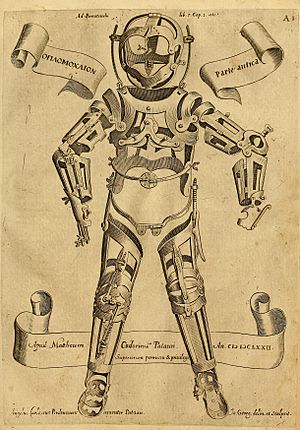Hieronymus Fabricius facts for kids
Quick facts for kids
Hieronymus Fabricius
|
|
|---|---|

Girolamo Fabrizi d' Acquapendente
|
|
| Born | 20 May 1533 Acquapendente
|
| Died | 21 May 1619 (aged 86) |
| Nationality | Italian |
| Education | University of Padua (M.D., 1559) |
| Scientific career | |
| Fields | Anatomy |
| Institutions | University of Padua |
| Doctoral advisor | Gabriele Falloppio |
| Doctoral students | William Harvey Adriaan van den Spiegel Johannes Heurnius Jan Jesenius |
Girolamo Fabrici d'Acquapendente, also known as Hieronymus Fabricius (born May 20, 1533 – died May 21, 1619), was an important anatomist and surgeon. He is often called "The Father of Embryology" because of his groundbreaking work in this field.
Contents
A Pioneer in Medical Science
Fabricius was born in Acquapendente, a town in Italy. He studied at the University of Padua, a famous university in Italy. In 1559, he earned his medical degree. His teacher was Gabriele Falloppio, another well-known anatomist.
From 1562 to 1565, Fabricius taught anatomy privately. In 1565, he became a professor at the University of Padua. He took over from his former teacher, Falloppio, teaching both surgery and anatomy.
Revolutionizing Anatomy Teaching
In 1594, Fabricius changed how anatomy was taught. He designed and built the first permanent theater for public dissections. This special building made it easier for students to learn about the human body.
Many famous students learned from Fabricius. These included William Harvey (who later discovered how blood circulates) and Adriaan van den Spiegel. Julius Casserius was also one of his students. Casserius later became a professor of anatomy at Padua, following Fabricius.
Discoveries About the Body
Fabricius studied many parts of the body by dissecting animals. He looked at how a fetus forms and how the esophagus, stomach, and intestines work. He also studied the eye, ear, and larynx (voice box).
One of his most important discoveries was about the "valves" inside veins. These are like tiny doors that prevent blood from flowing backward. Fabricius fully described these valves in 1603. While he didn't understand that they helped blood flow towards the heart, his student William Harvey later used this knowledge to figure out blood circulation.
Fabricius also described a special groove in the brain. This groove separates the temporal lobe from the frontal lobe. Today, it's often called the Sylvian fissure.
The Bursa Fabricii is a part of a bird's body. It is named after Fabricius because he was the first to describe it. This part of a bird helps make blood cells.
Contributions to Surgery
Fabricius also made big contributions to surgery. He wrote about a surgical procedure called a tracheotomy. This operation involves making an opening in the windpipe (trachea). It helps people breathe when their airway is blocked.
Fabricius suggested using a straight, short tube for the tracheotomy. This tube had "wings" to stop it from going too far into the windpipe. He believed this operation should only be used when absolutely necessary. His description of the tracheotomy is very similar to how it is done today.
Books
Fabricius wrote many important books about anatomy and surgery. One of his famous works was De Formatione Ovi et Pulli. This book described how eggs and chicks develop. He also wrote De Venarum Ostiolis (On the Valves of the Veins), which described his findings about vein valves.
See also
 In Spanish: Girolamo Fabrizi d'Acquapendente para niños
In Spanish: Girolamo Fabrizi d'Acquapendente para niños
- Anatomical Theatre of Padua
- Andreas Vesalius
- Galen


